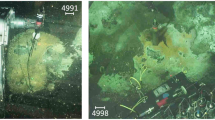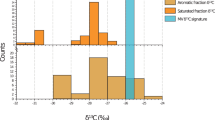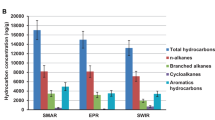Abstract
The widespread occurrence of extended hopanoids in sediments and petroleums illustrates the importance of bacterial lipid contributions to geological materials1. In archaebacteria, however, hopanoids are absent1; their role as structural components of biomembranes is fulfilled by acyclic isoprenoids1–5. Recent studies2–6 of the lipid constituents of archaebacteria have greatly extended the range of acyclic isoprenoid skeletons known in organisms (Fig. 1). In particular, isoprenoids with head-to-head linkages have been identified3–5, and such compounds (for example, 3,7,11,15,18,22,26,30-octamethyldotriacontane, I) have been recognized in petroleums7,8 and as degradation products of Messel shale kerogen9–11. Here we report the first recognition of 2,6,10,15,19-pentamethyleicosane (II), a known component of methanogens5,6, in marine sediments of Recent to Cretaceous age (Table 1) and suggest that it and certain other acyclic isoprenoids may be used as biological markers for methanogens.
This is a preview of subscription content, access via your institution
Access options
Subscribe to this journal
Receive 51 print issues and online access
$199.00 per year
only $3.90 per issue
Buy this article
- Purchase on Springer Link
- Instant access to full article PDF
Prices may be subject to local taxes which are calculated during checkout
Similar content being viewed by others
References
Ourisson, G., Albrecht, P. & Rohmer, M. Pure appl. Chem. 61, 709–729 (1979).
Kates, M. in Ether Lipids, Chemistry and Biology (ed. Synder, F. S.) 351–398 (Academic, New York, 1972).
Tornabene, T. G. & Langworthy, T. A. Science 203, 51–53 (1979).
De Rosa, M., De Rosa, S., Gambacorta, A. & Bu'Lock, J. D. Chem. Commun. 514–515 (1977).
Tornabene, T. G., Langworthy, T. A., Holzer, G. & Oro, J. J. molec. Evol. 13, 73–83 (1979).
Holzer, G., Oro, J. & Tornabene, T. G. J. Chromatogr. 186, 795–809 (1979).
Moldowan, J. M. & Seifert, W. K. Science 204, 169–171 (1979).
Albaiges, J. in Advances in Organic Geochemistry 1979 (eds Douglas, A. G. & Maxwell, J. R.) 19–28 (Pergamon, Oxford, 1980).
Michaelis, W. & Albrecht, P. Naturwissenschaften 66, 420–422 (1979).
Chappe, B., Michaelis, W. & Albrecht, P. in Advances in Organic Geochemistry 1979 (eds Douglas, A. G. & Maxwell, J. R.) 265–274 (Pergamon, Oxford, 1980).
Chappe, B., Michaelis, W., Albrecht, P. & Ourisson, G. Naturwissenschaften 66, 522–523 (1979).
Gardner, P. M. & Whitehead, E. V. Geochim. cosmochim. Acta 36, 259–263 (1972).
Dastillung, M., Albrecht, P., Tissier, M. J. in Géochimie Organique des Sédiments Marins Profonds. Organ I, Merde Norvège, 209–228 (CNRS, Paris, 1977).
Dastillung, M. & Corbet, M. in Géochimie Organique des Sédiments Marins Profonds. Orgon II; Atlantique-N. E. Brésil, 293–323 (CNRS, Paris, 1978).
Brassell, S. C. et al. Init. Rep. DSDP Leg. 56/57, Part 2, 1367–1390 (1980); in Advances in Organic Geochemistry 1979 (eds Douglas, A. G. & Maxwell, J. R.) 375–392 (Pergamon, Oxford, 1980).
Wardroper, A. M. K. thesis, Univ. Bristol (1979).
Brassell, S. C. thesis, Univ. Bristol (1980).
Blumer, M., Mullin, M. M. & Thomas, D. W. Science 140, 974 (1963).
Brassell, S. C., Gowar, A. P. & Eglinton, G. in Advances in Organic Geochemistry 1979 (eds Douglas, A. G., & Maxwell, J. R.) 421–426 (Pergamon, Oxford, 1980).
Spyckerelle, C., Arpino, P. & Ourisson, G. Tetrahedron 28, 5703–5713 (1972).
Albaiges, J., Borbon, J. & Salagre, P. Tetrahedron Lett. 595–598 (1978).
Han, J. & Calvin, M. Geochim. cosmochim Acta 33, 739–742 (1969).
Haug, P. & Curry, D. J. Geochim. cosmochim. Acta 38, 601–610 (1974).
Waples, D. W., Haug, P. & Welte, D. H. Geochim. cosmochim. Acta 38, 381–387 (1974).
Kaplan, I. R. & Baedecker, M. J. Israel J. Chem. 8, 529–533 (1970).
Comet, P. A. et al. Init. Rep. DSDP Leg 62 (in the press).
Whelan, J. K., Hunt, J. M. & Berman, J. Geochim. cosmochim. Acta 44, 1767–1785 (1980).
Hammond, D. E., Horowitz, R. M., Broecker, W. S. & Bopp, R. Init. Rep. DSDP Leg 20, 765–771 (1972).
Whelan, J. K. & Hunt, J. M. Init. Rep. DSDP Leg 56/57, Part 2, 1349–1365 (1980).
Whelan, J. K. & Hunt, J. M. Init. Rep. DSDP Leg 50, 623–624 (1980).
Von Huene, R. et al. Geotimes 23(4), 16–21 (1978).
Cox, R. E., Maxwell, J. R., Ackman, R. G. & Hooper, S. N. Can. J. Biochem. 50, 1238–1241 (1972).
Patience, R. L., Rowland, S. J. & Maxwell, J. R. Geochim. cosmochim. Acta 42, 1871–1875 (1978).
Didyk, B. M., Simoneit, B. R. T., Brassell, S. C. & Eglinton, G. Nature 272, 216–222 (1978) and refs therein.
Howard, D. L. thesis, Univ. California, Los Angeles (1980).
Cardoso, J. N. et al. Init. Rep. DSDP Leg 44, 965–976 (1979).
Brassell, S. C. et al. Init. Rep. DSDP Leg 50, 647–664 (1980).
Thomson, I. D., Brassell, S. C., Eglinton, G. & Maxwell, J. R. Init. Rep. DSDP Leg 64, (in the press).
Curray, J. R et al. Geotimes 24(7), 18–20 (1979).
Simoneit, B. R. T., Mazurek, M. A., Brenner, S., Crisp, P. T. & Kaplan, I. R. Deep Sea Res. 26 A, 879–891 (1979).
Oremland, R. S., Culbertson, C. & Simoneit, B. R. T. Init. Rep. DSDP Leg 64, (in the press).
Belyaev, S. S., Lein, A., & Ivanov, M. V. in Biogeochemistry of Ancient and Modem Environments (eds Trudinger, P. A., Walter, M. R. & Ralph, B. J.) 235–242 (Australian Academy of Science, Canberra, 1980).
Romesser, J., Wolfe, R. S., Mayer, F., Spiess, E. & Walter-Mauruschat, A. Arch. Microbiol. 121, 147–153 (1979).
Farrington, J. W., Frew, N. M., Gscwend, P. M. & Tripp, B. W. Estuarine Coastal mar. Sci. 5, 793–808 (1977).
Boehm, P. D. & Quinn, J. G. Estuarine Coastal, mar. Sci. 6, 471–494 (1978).
Kimble, B. J. thesis, Univ. Bristol (1972).
Corbet, B., Albrecht, P. & Ourisson, G. J. Am. chem. Soc, 102, 1171–1173 (1980).
Author information
Authors and Affiliations
Rights and permissions
About this article
Cite this article
Brassell, S., Wardroper, A., Thomson, I. et al. Specific acyclic isoprenoids as biological markers of methanogenic bacteria in marine sediments. Nature 290, 693–696 (1981). https://doi.org/10.1038/290693a0
Received:
Accepted:
Issue Date:
DOI: https://doi.org/10.1038/290693a0
This article is cited by
-
Organic geochemical characteristics and significance of Permian Gufeng formation siliceous shale in well CSDP-2 of South Yellow Sea central uplift
Acta Geochimica (2023)
-
Comparison of Formation Conditions of Source Rocks of Fengcheng and Lucaogou Formations in the Junggar Basin, NW China: Implications for Organic Matter Enrichment and Hydrocarbon Potential
Journal of Earth Science (2023)
-
Asynchronous responses of aquatic ecosystems to hydroclimatic forcing on the Tibetan Plateau
Communications Earth & Environment (2022)
-
Distribution difference and significance of short-chain steranes in humic coal and coal-measure mudstone of Triassic Xujiahe formation in Sichuan Basin, SW China
Arabian Journal of Geosciences (2021)
-
Geochemical characteristics and genetic families of crude oil in DWQ oilfield, Kuqa Depression, NW China
Journal of Petroleum Exploration and Production Technology (2021)
Comments
By submitting a comment you agree to abide by our Terms and Community Guidelines. If you find something abusive or that does not comply with our terms or guidelines please flag it as inappropriate.



